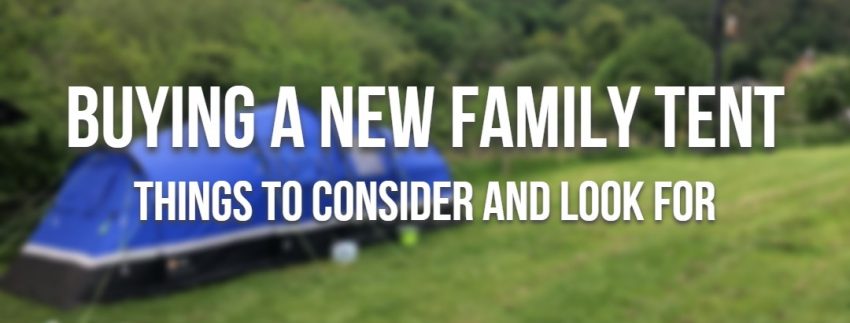After nearly 10 years of faithful service, our trusty Zenobia 6 tent looks like it might be on its way out. On our most recent trip, not only did we find quite a bit of rain coming through the roof at night, we’ve also got a couple of tent poles that needed drastic running repairs. All in all, this year might be the last time we trust it for our camping shelter needs.
After a recent trip to ‘Go Outdoors’ to look at the sort of tents we might replace it with – and to decide whether we still need one big, family tent (or should get the boys a smaller tent of their own) it struck me that there are quite a few confusing aspects to buying a tent – and a few things I’ve learnt over the past 10 years that might be helpful to share. So here goes…
Consider the occupancy carefully
I’ve never quite understood why, but tent manufacturers seem to vastly underestimate the amount of space a person takes up in a tent. I’ve always suspected they were basing it on the sort of campers who climb Mount Everest and need to huddle to stay warm – because it sure as hell isn’t accurate for any family campers I’ve met.

As a rule, ignore the suggested occupancy size and assume you’ll need at least 50% more space than they say. So a family of four should, if possible, go with a 6-person tent. But there’s no substitute for getting inside and trying it our first, so if you’re near an outdoor shop that lets you get inside the tents before you buy them, go and have a poke around first.
Space to ‘live’ in is important too
As well as the all-important bedroom size, you’re going to need a bit of space to move around in outside the bedroom, too. Whether it’s an “ante-chamber” between bedroom pods or a large area at the front, this area is where you’re going to store all of your STUFF – and may be where you end up eating if the weather turns bad.
So as much as the temptation might be to cut down on ‘wasted’ space, consider what you’re going to be doing if plans don’t work out in your favour – either through weather, or tiredness, or just a place to chill when the sun gets too hot.
‘Black out’ material can be invaluable
A lot of modern tents come with built-in ‘black-out’ material, either for the entire tent or just the bedroom sections. While it might seem like a pointless extra at first, take it from this camper: when you’re camping in the height of summer, not having to wake up when the sun rises can be a real blessing. Even more so when you’re with small children who might be used to sleeping in a darkened room.
Consider how easy it is to erect / dismantle
Having spent the past 10 years wrestling with tent poles and bending tent pegs, I’m now at the stage where the idea of in inflatable tent is VERY tempting – particularly because of the time they take to put up. A few friends of ours have inflatable tents now, and they genuinely do take a fraction of the time to get up compared to ours.
Dismantling and putting away tents can be a right old faff too – particularly if the bag they come in doesn’t have much room to manoeuvre. If you’re folding it up in a hurry, or trying to squeeze all the air out of all the nooks and crannies, being able to shove it all in the bag without having to steamroller it flat can be a real blessing. So consider both erection and dismantling when you do your research.
Check the tent footprint (including guide ropes)
This might seem like an odd thing to mention, but some campsites specify a certain area as your pitch (we went to one recently that even marked it out with paint) – and our long, thing tent almost didn’t fit inside the pitch we’d paid for. Next time, I’d definitely consider something a little squarer – though admittedly this is the first time we’ve had to consider this, so it may be a rarity.
Splash out on a few extras (if you can)
If you can afford to push the boat out and get a few accessories with the tent, there are definitely some that are more useful than others. I’d suggest the following as a starter:
- A ground-sheet for underneath the tent can help to keep the main tent dry – and may aid in putting away, too. It also adds an extra layer of warmth between you and a possibly cold floor.
- An awning can give you a little bit of extra space when you need it – and if it’s detachable, you only need to take it when you want it.
- A few extra tent pegs never does any harm – inevitably some will bend while you’re using them, and a dozen or two “super strong” pegs are always useful to have at hand, too.
So those are the main tips I’ve thought of, but I’d love any suggestions for others in the comments below! Thanks for reading – and happy camping!


